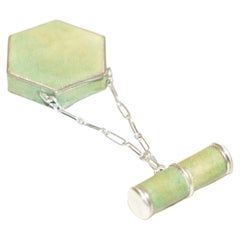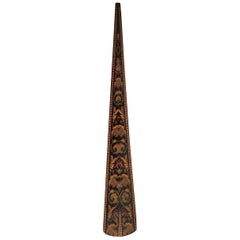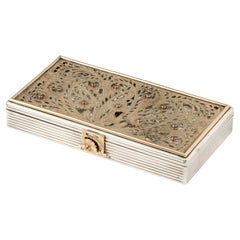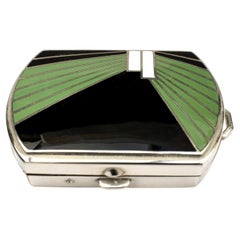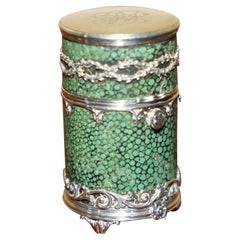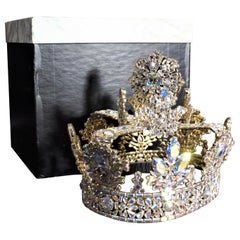High Victorian Collectible Jewelry
to
1
1
2
340
143
90
51
51
50
27
12
10
9
8
5
2
2
1
2
1
1
1
1
1
2
1
1
2
2
2
Style: High Victorian
VERY FINE ANTIQUE VICTORIAN SHAGREEN LADiES POWDER COMPACT & LIPSTICK CASE
Located in West Sussex, Pulborough
Royal House Antiques
Royal House Antiques is delighted to offer for sale this absolutely stunning Victorian circa 1880 ladies Shargeen & Silver powder compact with lipstick...
Category
1880s European Antique High Victorian Collectible Jewelry
Materials
Sterling Silver
Rare 19th Century English Tunbridgeware Hair Pin or Slide
Located in Dallas, TX
PRESENTING an EXTREMELY UNIQUE and RARE 19C British Tunbridgeware Hair Pin/Bobbin or Slide.
This slide is unlike any of it’s kind we have seen before, it is a VERY RARE survivor.
From circa 1860 – 80 and made in Tunbridge Wells, England.
Made of walnut with gorgeous marquetry inlay on the entirety of the front with classic Tunbridgeware micro-mosaic all over the front. The rear is walnut.
The marquetry inlay appears to be various different woods, namely, maple, walnut and satinwood.
Would have been worn in a Lady’s hair bun with the micro-mosaic facing forward.
This would have belonged to a VERY ELEGANT LADY in the mid to late 19th Century.
Tunbridge ware is a form of decoratively inlaid woodwork, typically in the form of boxes, that is characteristic of Tonbridge and the spa town of Royal Tunbridge Wells in Kent in the 18th and 19th centuries. The decoration typically consists of a mosaic of many very small pieces of different coloured woods that form a pictorial vignette. Shaped rods and slivers of wood were first carefully glued together, then cut into many thin slices of identical pictorial veneer with a fine saw. Elaborately striped and feathered bandings for framing were pre-formed in a similar fashion.
There is a collection of Tunbridge ware in the Tunbridge Wells Museum and Art Gallery in Tunbridge Wells.
The famous makers of Tunbridge ware were in the Tunbridge Wells area of Kent; their most notable work was from circa 1830-1900.
Early makers of Tunbridge ware, in Tunbridge Wells in the mid-18th century, were the Burrows family, and Fenner and Co. In the 19th century, around 1830, James Burrows invented a technique of creating mosaics from wooden tesserae. Henry Hollamby, apprenticed to the Burrows family, set up on his own in 1842 and became an important manufacturer of Tunbridge ware, employing about 40 people.
Edmund Nye (1797–1863) and his father took over the Fenner company when William Fenner retired in 1840, after 30 years in partnership with him. Thomas Barton (1819–1903), previously apprenticed at the Wise factory, joined the Nyes in 1836, and worked as Nye’s designer; he took over the business in 1863 and continued there until his death.
In Tonbridge (near to Tunbridge Wells), George Wise (1703–1779) is known to have had a business in 1746. It continued with his son Thomas, and Thomas’s nephew George (1779–1869), who took over in 1806. In its early years the company made articles such as workboxes and tea caddies with prints of popular views; later items had pictures created from mosaics. Their workshop in Tonbridge, Wise’s Tunbridge Ware Manufactory, was next to the Big Bridge over the Medway; the building was demolished in 1886 to widen the approach to the bridge.
Tunbridge ware became popular with visitors to the spa town of Tunbridge Wells, who bought them as souvenirs and gifts. Articles included cribbage boards, paperweights, writing slopes, snuffboxes and glove boxes.
At the Great Exhibition of 1851, Tunbridge ware by Edmund Nye, Robert Russell and Henry Hollamby was shown; Edmund Nye received a commendation from the judges for his work. He exhibited a table depicting a mosaic of a ship at sea; 110,800 tesserae were used in making the picture.
The manufacturers of Tunbridge ware were cottage industries, and they were no more than nine in Tunbridge Wells and one in Tonbridge. The number declined in the 1880s; competent craftsmen were hard to find, and public tastes changed. After the death of Thomas Barton in 1903 the only surviving firm was Boyce, Brown and Kemp, which closed in 1927.
Marquetry was an old technique which was continued by Nye and Barton to create images such as birds or butterflies.
‘Green Oak’ as caused by the fungus Chlorociboria aeruginascens.
Stickware and half-square mosaic was invented by James Burrows in about 1830: a bunch of wooden sticks of different colours, each having triangular or diamond-shaped cross section, were tightly glued together; in the case of stickware, the resulting block was dried, then turned to form an article such as the base of a pincushion. For half-square mosaic, thin slices were taken from the composite block, and applied to a surface.
Tesselated mosaic, was a development by James Burrows of half-square mosaic; it was adopted by George Wise and Edmund Nye. Minute tesserae were used to form a wide variety of geometric and pictorial designs.
Many sorts of wood were used for the various colours; about 40 were in regular use. Only natural colors were used; green was provided by “green oak”, produced by the action of fungus on fallen oak. Designs for articles were often taken from designs of Berlin wool work.
Category
Late 19th Century English Antique High Victorian Collectible Jewelry
Materials
Satinwood, Walnut
Related Items
Oversized Vintage French Silver Compact Case by Boucheron
By Boucheron
Located in Atlanta, GA
A large silver compact case with gilt surface and inset rubies by Boucheron Paris circa 1930s-1940s, of Art Deco period and style. The silver case is quote large compared to similar ...
Category
Mid-20th Century French High Victorian Collectible Jewelry
Materials
Multi-gemstone, Silver
Art Deco French Chrome & Enamel Ladies Powder Compact, C1930s
Located in Devon, England
This is a really cute and rare find, a 1930's Art Deco compact with the most delightful green and black enamel decoration on a chrome casing . The interior is an engineers delight with a sliding latch on the side of the compact to secure the power in place. Upon opening the lid reveals the mechanics that operates and reveals a powder dispenser...
Category
Mid-20th Century French High Victorian Collectible Jewelry
Materials
Enamel, Chrome
Art Deco 1928 Ladies Compact by Richard Hudnut
Located in Devon, England
For your consideration is this excellent condition Art Deco ladies combination compact dating to 1928. This is a classic Art Deco Richard Hudnut Le Debut Cloisonné Powder, Rouge and Mirror Compact and is an absolute delight in every aspect and genuinely has appears never to have been used.
This compact features a black enamel lid with cream dotted accents; the back of the compact has a spider web machine-tooled finish to accent the octagonal shape of the compact. The case opens to a rouge compartment with a mirror in the lid that is behind a gold toned Art Deco decorated cover. The loose powder compartment is in the lower section of the compact; and it has a hinged and latched recessed door to hold a puff. This feature was a later addition to the initial solid powder product release of 1924 and has the patent date stamped on the underside of the hinged door reflecting an issue date of 1928. The original rouge is in untouched condition and still shows the embossed name Le Debut while the loose powder well is empty. Inside it is hallmarked "Le Debut", "Richard Hudnut" on the Art Deco mirror frame...
Category
Mid-20th Century North American High Victorian Collectible Jewelry
Materials
Enamel, Chrome
Rare 19th Century Meerschaum Pipe – Bullfight Scene
Located in Madrid, ES
Exceptional and rare 19th century meerschaum pipe, finely carved, depicting a detailed bullfight scene. The composition depicts a dramatic moment where one bullfighter is assisted by...
Category
19th Century Spanish Antique High Victorian Collectible Jewelry
Materials
Organic Material
Late 19th Century English Diorama Clipper Ship Shadowbox
Located in Queens, NY
Late 19th century English Victorian painted diorama wall plaque of clipper ship with red flag painted in cloudy sky in mahogany frame.
Category
Late 19th Century British Antique High Victorian Collectible Jewelry
Materials
Mahogany
Victorian Cased Taxidermy, Pheasant
Located in London, GB
Victorian cased taxidermy of a pheasant amongst natural Habitat.
Dimension: H 55.5 x W 80 x D 23 cm.
Category
Late 19th Century English Antique High Victorian Collectible Jewelry
Materials
Glass, Wood, Feathers, Animal Skin
Art Deco 1928 Ladies Compact by Richard Hudnut
Located in Devon, England
For your consideration is this virtually mint condition Art Deco ladies combination compact dating to 1928. This is a classic Art Deco Richard Hudnut Le Debut Cloisonné Powder, Rouge...
Category
Mid-20th Century North American High Victorian Collectible Jewelry
Materials
Enamel, Chrome
19th Century Pet or Doll Bed
Located in East Hampton, NY
Exquisite pet/ doll bed in the Louis XXI style. all original silk brocade drapery and upholstery. and remnants of trims. mattress is stuffed horsehair. ostrich feather floret. (the h...
Category
Mid-19th Century Antique High Victorian Collectible Jewelry
Materials
Silk
Vintage Swiss Powder Compact in Mother of Pearl & Gold Plating
Located in Esbjerg, DK
A stylish vintage powder compact with mirror executed in gold plated metal and showcasing a front tiled with mother of pearl. Swiss made circa 1930-60. Measurements: D: 8 cm, H:dept:...
Category
Mid-20th Century Swiss High Victorian Collectible Jewelry
Materials
Gold Plate
$259 Sale Price
20% Off
H 0.56 in Dm 3.15 in
Late 19th Century English Game Box
Located in Casteren, Noord-Brabant
Lovely antique game box, made of mahogany.
The box contains several games, with many bits and pieces. Not all complete.
It is obviously that there h...
Category
1890s British Antique High Victorian Collectible Jewelry
Materials
Wood
Tall Antique Taxidermy Showcase, English, Display Dome, Specimen Case, Victorian
Located in Hele, Devon, GB
This is a tall antique taxidermy showcase. An English, glass and mahogany display dome, dating to the late Victorian period, circa 1890.
Pleasingly bright and well-proportioned ant...
Category
Late 19th Century British Antique High Victorian Collectible Jewelry
Materials
Glass, Wood
$1,219
H 22.05 in Dm 9.45 in
Late 19th Century English Copper & Brass Bugle
Located in Chapel Hill, NC
Late 19th century copper & brass bugle, English. Military Regimental Crest of the Argyll & Sutherland Highlanders Regiment (1881-2006 when folded into the Royal Regiment of Scotland)...
Category
Late 19th Century English Antique High Victorian Collectible Jewelry
Materials
Brass, Copper
Previously Available Items
ANTIQUE VICTORIAN CIRCA 1860 WATERSTON LONDON SiLVER SHAGREEN SCENT BOTTLE CASE
Located in West Sussex, Pulborough
Royal House Antiques
Royal House Antiques is delighted to offer for sale this very rare and highly collectable, Watherston London Victorian Scent bottle case in silver and Shagreen
A very good looking well made and decorative piece, it is as mentioned a scent bottle holder for snuff or perfume, super collectable and very very rare
Made by the firm of Watherston London
James Henderson Watherston, who had been in business with John Brogden (qv), and his son Edward James Watherston were the original partners of this firm of manufacturing goldsmiths, jewellers and gold chain makers. In 1902 they moved to 6 Vigo Street, Regent Street where they remained until closing in 1910
The piece is in exquisite condition, there's no bottle inside as you can see, its the case only...
Category
1860s English Antique High Victorian Collectible Jewelry
Materials
Silver
Large & Very Elaborate Costume Jewelry Prong Set AB Clear Rhinestone Crown & Box
Located in Hamilton, Ontario
This full sized and very elaborate rhinestone crown is completely unsigned, but presumed to have been made in Canada in circa 1975 in a Victorian or ...
Category
Late 20th Century Canadian High Victorian Collectible Jewelry
Materials
Paste
H 8.25 in W 9 in D 11 in
Antique Rose Quartz Tusk Seed Pearl Necklace
Located in West Palm Beach, FL
Antique rose quartz tusk gold plated seed pearl necklace, beautifully mounted and carved 2.5" long x 1" rose rock crystal a 17" gold-plated chain.
Category
Early 20th Century European High Victorian Collectible Jewelry
Materials
Gold Plate
High Victorian collectible jewelry for sale on 1stDibs.
Find a broad range of unique High Victorian collectible jewelry for sale on 1stDibs. Many of these items were first offered in the 19th Century, but contemporary artisans have continued to produce works inspired by this style. If you’re looking to add vintage collectible jewelry created in this style to your space, the works available on 1stDibs include more furniture and collectibles and other home furnishings, frequently crafted with metal, silver and other materials. If you’re shopping for used High Victorian collectible jewelry made in a specific country, there are Europe, England, and United Kingdom pieces for sale on 1stDibs. It’s true that these talented designers have at times inspired knockoffs, but our experienced specialists have partnered with only top vetted sellers to offer authentic pieces that come with a buyer protection guarantee. Prices for collectible jewelry differ depending upon multiple factors, including designer, materials, construction methods, condition and provenance. On 1stDibs, the price for these items starts at $360 and tops out at $842 while the average work can sell for $842.
Recently Viewed
View AllMore Ways To Browse
Victorian Antique Boots
Vintage 1950s Formica Kitchen Table
Vintage Bernhardt Dining Room Furniture
Vintage Ceramic Pheasants
Vintage Entertainment Cabinets
Vintage Escutcheon Plate
Vintage Glass Table Top Display Case
Vintage Hawaii Poster
Vintage Heywood Wakefield Rattan Furniture
Vintage Hungarian Dress
Vintage Linoleum
Vintage Mirror Trays
Vintage Olympic Torch
Vintage Pink Glass Decanter
Vintage Record Player In Cabinet
Vintage Rosenthal Figurines
Vintage Steuben Vases
Vintage Stoves 1930
